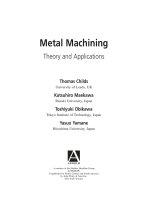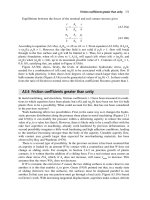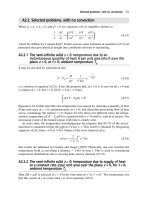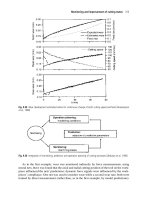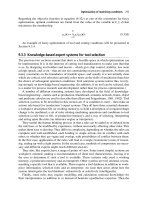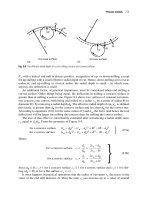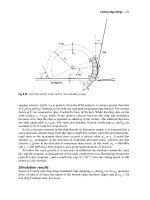Metal Machining - Theory and Applications Episode 2 Part 10 pot
Bạn đang xem bản rút gọn của tài liệu. Xem và tải ngay bản đầy đủ của tài liệu tại đây (171.07 KB, 20 trang )
Equilibrium between the forces of the nominal and real contact stresses gives
t A
r
s
— = —— — (A3.16a)
kA
n
k
s
n
A
r
p
r
— = —— — (A3.16b)
kA
n
k
According to equation (A3.16a), A
r
/A
n
⇒ t/k as s/k ⇒ 1. From equation (A3.16b), if A
r
/A
n
< (s
n
/k), p
r
/k > 1. However, the slip-line field is not valid if p
r
/k > 1: flow will break
through to the free surface and p
r
/k will be limited to 1. Thus, for a plastic asperity on a
plastic foundation, when s/k is close to 1, A
r
/A
n
will equal (t/k) when (t/k) > (s
n
/k), and
(s
n
/k) when (s
n
/k) > (t/k), up to its maximum possible value of 1. Contours of A
r
/A
n
= 1,
0.9, 0.8, satisfying this, are added to Figure A3.9(b).
Figure A3.9(b) shows, firstly, the levels of dimensionless hydrostatic stress, p
E
/k,
needed for a combination of (t/k) and (s
n
/k) to be associated with a bulk plastic flow. If
there is bulk plasticity, it then shows how degrees of contact much larger than when the
bulk remains elastic (Figure A3.8a) can be generated at values of (s
n
/k) < 1. In these condi-
tions the ratio of friction to normal stress (the friction coefficient) becomes greater than 1.
A3.6 Friction coefficients greater than unity
In metal machining, and elsewhere, friction coefficients > 1 have been measured in condi-
tions in which asperities have been plastic but (t/k) and (s
n
/k) have been too low for bulk
plastic flow to be a possibility. What could account for this, that has not been considered
in the previous sections?
Work hardening offers two possibilities. First, in the same way as it changes the hydro-
static pressure distribution along the primary shear plane in metal machining (Figures 2.11
and 6.9(b)), it can modify the pressure within a deforming asperity to reduce the mean
value of p
r
to a value less than k. However, there is likely only to be a small effect with the
rake face asperities in machining, already work hardened by previous deformations. A
second possibility imagines a little work hardening and high adhesion conditions, leading
to the interface becoming stronger than the body of the asperity. Unstable asperity flow,
with contact area growth larger than expected for non-hardening materials, has been
observed by Bay and Wanheim (1976).
There is a second type of possibility. In the previous sections it has been assumed that
an asperity is loaded by an amount W by contact with a counterface and that W does not
change as sliding starts. For example, in Section 3.4.2 on junction growth of plastic
contacts, it is written that the addition of a sliding force F to a real contact area creates an
extra shear stress F/A
r
which, if A
r
does not increase, will cause t
max
to increase. This
assumes that the stress W/A
r
does not decrease.
If W is constant, the extra force F causes the two sliding surfaces to come closer to one
another: it is this that enables A
r
to grow. Green (1955) pointed out that, in a steady state
of sliding (between two flat surfaces), the surfaces must be displaced parallel to one
another. In that case any one junction must go through a load cycle. Figure A3.10 is based
on Green’s work. With increasing tangential displacement, asperities make contact, deform
Friction coefficients greater than unity 373
Childs Part 3 31:3:2000 10:43 am Page 373
and break. The load rises, passes through a maximum and falls, but the friction force rises
and stays constant until failure. If, at any one time, there are many contacts in place, each
at a random point in its life cycle, an average friction coefficient will be observed that is
obtained from the areas under the curves of Figure A3.10, up to the point of failure. Green
argued that when conditions were such that junctions failed when the load dropped to zero,
the friction coefficient would be unity. Higher coefficients require junctions to be able to
withstand tensile forces, as shown. The exact value of the friction coefficient will depend
on the exact specification of how the surfaces come together and move apart; and on the
junctions’ tensile failure laws. Quantitative predictions do not exist.
References
Bay, N. and Wanheim, T. (1976) Real area of contact and friction stress at high pressure sliding
contact. Wear 38, 201–209.
Childs, T. H. C. (1973) The persistence of asperities in indentation experiments. Wear 25, 3–16.
Green, A. P. (1955) Friction between unlubricated metals: a theoretical analysis of the junction
model. Proc. Roy. Soc. Lond. A228, 191–204.
Greenwood, J. A. and Williamson, J. B. P. (1966) Contact of nominally flat surfaces. Proc. Roy. Soc.
Lond. A295, 300–319.
Johnson, K. L. (1985) Contact Mechanics. Cambridge: Cambridge University Press.
Oxley, P. L. B. (1984) A slip line field analysis of the transition from local asperity contact to full
contact in metallic sliding friction. Wear 100, 171–193.
Sutcliffe, M. P. (1988) Surface asperity deformation in metal forming processes. Int. J. Mech. Sci.
30, 847–868.
374 Appendix 3
Fig. A3.10 Qualitative junction load history for zero normal displacement
Childs Part 3 31:3:2000 10:43 am Page 374
Appendix 4
Work material: typical
mechanical and thermal
behaviours
This appendix holds data that support Chapters 3 and 7, in the first instance. In Chapter 3,
reference is made to yield and strain hardening behaviours of aluminium, copper, iron,
nickel and titanium alloys, as determined by room-temperature, low strain rate, compres-
sion testing. Information on this is given in Section A4.1. The thermal conductivity, heat
capacity and diffusivity ranges of these alloys, and their variations with temperature – also
used in Chapter 3 to estimate temperature rises during machining – are tabulated in Section
A4.2. In Chapter 7 the idea was developed that it is not the strain hardening behaviour of
the work materials at room temperature and low strain rates that is needed. What is impor-
tant for predicting chip formation in machining is the strain hardening behaviour at the
temperatures and strain rates that actually occur. Data on this are presented in Section
A4.3. This appendix is also a source for applications studies such as are described after
Chapter 7.
A4.1 Work material: room temperature, low strain rate,
strain hardening behaviours
Figures A4.1 to A4.3 contain representative strain hardening data for commercially pure
samples of aluminium, copper, iron, nickel and titanium, and their alloys. The data have
been obtained either from plane strain compression tests or from measuring the depen-
dence of yield stress of sheet samples upon reduction of their thickness through cold
rolling. In every case, the variation of shear stress, k, with shear strain, g, is shown. k has
been calculated from s—/
Ȉȉ
3 and g from e
—
Ȉȉ
3. The following is a brief commentary on the
figures.
Copper and aluminium alloys (Figure A4.1)
The copper and copper alloys (left-hand panel) are all initially in the annealed state. They
show the low initial yield and large amount of strain hardening typical of these face centred
cubic metals. The aluminium and aluminium alloys (right-hand panel) show a similar
behaviour, but generally at a lower level of stress. Some aluminium alloys can be hardened
Childs Part 3 31:3:2000 10:43 am Page 375
by ageing, either at room temperature (T4 temper) or above room temperature (T6). The
examples of Al2024 (an alloy with 4Cu) and Al6061 (an alloy with 0.5Mg0.5Si) show the
extent of hardening by this means. It could be argued that the 32Cu–66Ni alloy shown in
the figure is more properly a nickel alloy: it is included here because Figure A4.3, on
nickel alloys, is concerned more with Ni–Cr heat resistant alloys.
Ferrous alloys (Figure A4.2)
The left-hand panel contains data for carbon and low alloy steels as received from the hot
rolling process. In this state their microstructure is a mixture of ferrite and pearlite (or, for the
high carbon steel, pearlite and cementite). In contrast with the copper and aluminium alloys,
these body centred cubic materials show a large variation in initial yield stress and, relative to
the initial yield, less strain hardening. The right-hand panel shows two austenitic steels, a
stainless steel (18Cr8Ni) and a high manganese steel (18Mn5Cr). These face centred cubic
alloys show high strain hardening, both absolutely and relative to the body centred steels.
Nickel and titanium alloys (Figure A4.3)
All the nickel alloys (left-hand panel) shown in this figure are for high temperature, creep
resistant, use. Commercially they are known as Inconel or Nimonic alloys. They are face
centred cubic, with initial yield stress larger than copper alloys and large amounts of strain
hardening. The titanium alloys (right-hand panel) are hexagonal close packed (h.c.p.) or
mixtures of h.c.p. and body centred cubic. Their initial yield and strain hardening behav-
iours are intermediate between the face centred and body centred cubic materials.
Further elementary reading on metal alloys, their mechanical properties and uses can be
found in Rollason (1973), Cottrell (1975) and Ashby and Jones (1986).
A4.2 Work material: thermal properties
Tables A4.1 to A4.3 contain information on the variation with temperature of the thermal
conductivity, heat capacity and diffusivity of a range of work materials. The main single
376 Appendix 4
Fig. A4.1 Shear stress-strain behaviours of some copper and aluminium alloys
Childs Part 3 31:3:2000 10:43 am Page 376
Thermal properties 377
Fig. A4.2 Shear stress-strain behaviours of some ferritic/pearlitic and austenitic steels
Fig. A4.3 Shear stress-strain behaviours of some nickel and titanium alloys
Childs Part 3 31:3:2000 10:43 am Page 377
378 Appendix 4
Table A4.1 Thermal conductivity [W/mK] of some work material groups
Alloy system Temperature [°C]
0 200 400 600 800
Iron and steel
pure iron* 85 64 50 38 31
0.04–0.25C 52–60 48–54 42–45 35–37 29–30
0.25–0.8C 51–52 46–48 39–42 33–35 29–30
0.8–1.2C 45–51 42–46 37–39 32–33 27–29
low alloy 25–49 30–45 32–40 30–35 27–30
ferritic stainless 21–24 22–25 23–26 24–27 25–29
austenitic stainless 14–17 15–18 17–21 22–25 26–29
high manganese 14 16 19 21 22
Aluminium
pure, 1000 series 200–240 200–230 200–225 190–220 –
2000 to 7000 series 120–190 160–200 170–210
Al-Si cast alloys 170–190 170–190 – – –
Copper
pure copper* 380–400 375–395 350–380 320–360 270–330
60/70Cu–40/30Zn 90–120 90–140 110–150 120–150 –
90/95Cu–10/5Sn 50–80 70–100 90–120 – –
60/90Cu–40/10Ni 20–50 30–70 45–90 60–110 –
Nickel
pure nickel* 88–94 66–73 54–62 59–67 65–74
70Ni–30Cu 22 28 34 40 46
Superalloys** 11–12.5 11–14 13–16 16–20 20–24
Titanium
pure titanium* 22 21 21 21 –
α
,
α
–
β
,
β
alloys 5.5–8 8–12 10–17 12.5–21 15–25
Ti-6Al-4V 6.6–6.8 8.5–9.1 10.5–12.5 13–16 16–19
*: high and commercial purity; **: including cobalt- and ferrous-base superalloys.
Table A4.2 Heat capacity (MJ/m
3
) of some work material groups
Alloy system Temperature [°C]
0 200 400 600 800
Iron and steel
pure iron, C, low alloy 3.5–3.8 4.1–4.3 4.7–5.0 5.6–5.9 6.7–7.1
ferritic stainless 3.5–4.1 3.8–4.3 4.3–5.0 6.0–7.1 5.8–6.2
austenitic stainless 3.5–4.5 4.2–4.7 4.5–4.8 5.2–5.5 5.6–5.9
high manganese 3.9 4.6 – – –
Aluminium
pure, 1000 series 2.4–2.7 2.6–2.8 2.6–2.9 2.6–2.9 –
2000 to 7000 series 2.1–2.8 2.5–3.1 3.2–3.4 – –
Al-Si cast alloys 2.3 2.6 2.8 – –
Copper
pure copper* 3.3 3.7 3.9 – –
Zn, Sn, Ni alloys 3.2–3.4 3.6–3.8 3.8–4.0 – –
Nickel
pure nickel* 4.1 4.3 4.5 4.9 5.5
70Ni–30Cu 3.8 4.0 4.2 4.6 5.2
Superalloys** 3.3–3.5 3.5–3.6 3.7–3.8 4.2–4.3 4.5–4.8
Titanium
pure Ti*,
α
,
α
–
β
,
β
alloys 2.3–2.5 2.55–2.75 2.75–3.05 3.0–3.4 3.3–3.8
*: high and commercial purity; **: including cobalt- and ferrous-base superalloys.
Childs Part 3 31:3:2000 10:43 am Page 378
source of information has been the ASM (1990) Metals Handbook but it has been neces-
sary also to gather information from a range of other data sheets.
A4.3 Work material: strain hardening behaviours at high strain
rates and temperatures
Published data from interrupted high strain and heating rate Hopkinson bar testing (Chapter
7.4) are gathered here. Stress units are MPa and temperatures T are ˚C. Strain rates are s
–1
.
A4.3.1 Non-ferrous face centred cubic metals
For T from 20˚C to 300˚C, strain rates from 20 s
–1
to 2000 s
–1
and strains from 0 to 1, the
following form of empirical equation for flow stress, including strain path dependence, has
been established (Usui and Shirakashi, 1982)
B
– ——
e
—
˘
M
e
—
˘
mN
s
—
= A
(
e
T+273
)(
——
)(
∫
strain path
(
——
)
de
—
)
(A4.1a)
1000 1000
Strain hardening behaviours at high strain rates 379
Table A4.3 Diffusivity (mm
2
/s) of some work material groups
Alloy system Temperature [°C]
0 200 400 600 800
Iron and steel
pure iron* 23 15 10 6.5 4.5
0.04–0.25C 14–16 11–13 8.6–9.3 6.1–6.4 4.2–4.3
0.25–0.8C 14–15 11–12 8.1–8.7 5.7–6.1 4.2–4.3
0.8–1.2C 12–14 10–11 7.6–8.1 5.6–5.7 3.9–4.2
low alloy 7–13 7–11 6.6–8.2 5.2–6.1 3.9–4.3
ferritic stainless 5.1–6.8 5.1–6.5 4.6–6.0 3.4–4.5 4.0–5.0
austenitic stainless 3.2–3.7 3.5–4.0 3.8–4.4 4.0–4.8 4.4–5.2
high manganese 3.6 3.5 – – –
Aluminium
pure, 1000 series 78–100 75–90 70–80 73–76 –
2000 to 7000 series 52–75 55–72 50–65 – –
Al-Si cast alloys 75–85 65–75 – – –
Copper
pure copper* 115–120 100–110 90–100 – –
60/70Cu–40/30Zn 25–35 28–35 27–33 25–30 –
90/95Cu–10/5Sn 15–25 20–25 23–30 – –
60/90Cu–40/10Ni 6–15 8–18 12–22 – –
Nickel
pure nickel* 21–23 15–17 12–14 12–14 12–14
70Ni–30Cu 7.4 7.0 8.1 8.7 8.9
Superalloys** 2.8–3.8 3.1–3.9 3.5–4.2 3.8–4.7 4.2–5.3
Titanium
pure titanium* 9.5 7.6 6.8 – –
α
,
α
–
β
,
β
alloys 2.2–5.0 2.7–5.5 3.2–6.0 3.7–6.4 3.7–6.6
Ti-6Al-4V 2.2–3.0 2.7–3.5 3.2–3.8 3.8–4.2 3.8–4.7
*: high and commercial purity; **: including cobalt- and ferrous-base superalloys.
Childs Part 3 31:3:2000 10:43 am Page 379
For the special case of straining at constant strain rate, this simplifies to
B
– ——
e
—
˘
M+mN
s
—
= A
(
e
T+273
)(
——
)
e
–
N
(A4.1b)
1000
Coefficients A, B, M, m and N for the following annealed metals are as follows.
Metal ABM m N
Aluminium 107 153 0.057 0.064 0.3
a-brass 720 56.7 0.024 0.06 0.5
A4.3.2 Pearlitic carbon and low alloy steels
In early studies, an equation similar to equation (A4.1a) was used but for a changed expo-
nential temperature term and a term dependent on temperature within the strain path inte-
gral. Later, this was developed to
e
—
˘
M
e
—
˘
m
e
—
˘
–m/NN
s = A
(
——
)
e
aT
(
——
)(
∫
strain path
e
–aT/N
(
——
)
de
—
)
(A4.2a)
1000 1000 1000
to give a particularly simple form in constant strain rate and temperature conditions:
e
—
˘
M
–
s
—
= A
(
——
)
e
—
N
(A4.2b)
1000
A range of measured coefficients is given in Table A4.4, valid for T from 20˚C to 720˚C,
strain rates up to 2000 s
–1
and strains up to 1.
380 Appendix 4
Table A4.4 Flow stress data for annealed or normalized carbon and low alloy steels
Steel Coefficients of equation (A4.2)
0.1C A = 880e
–0.0011T
+ 167e
–0.00007(T–150)
2
+ 108e
–0.00002(T–350)
2
+ 78e
–0.0001(T–650)
2
[1]* M = 0.0323 + 0.000014TN= 0.185e
–0.0007T
+ 0.055e
–0.000015(T–370)
2
a = 0.00024 m = 0.0019
0.45C A = 1350e
–0.0011T
+ 167e
–0.00006(T–275)
2
M = 0.036
[2]* N = 0.17e
–0.001T
+ 0.09e
–0.000015(T–340)
2
a = 0.00014 m = 0.0024
0.38C A = 1460e
–0.0013T
+ 196e
–0.000015(T–400)
2
– 39e
–0.01(T–100)
2
–Cr–Mo M = 0.047 N = 0.162e
–0.001T
+ 0.092e
–0.0003(T–380)
2
[3]* a = 0.000065 m = 0.0039
0.33C A = 1400e
–0.0012T
+ 177e
–0.000030(T–360)
2
– 107e
–0.001(T–100)
2
–Mn–B M = 0.0375 + 0.000044T N = 0.18e
–0.0012T
+ 0.098e
–0.0002(T–440)
2
[3]* a = 0.000065 m = 0.00039
0.36C A = 1500e
–0.0018T
+ 380e
–0.00001(T–445)
2
+ 160e
–0.0002(T–570)
2
–Cr–Mo M = 0.017 + 0.000068T N = 0.136e
–0.0012T
+ 0.07e
–0.0002(T–465)
2
Ni[4]* a = 0.00006 m = 0.0025
*[1] Maekawa et al. (1991); [2] Maekawa (1998); [3] Maekawa et al. (1996); [4] Childs et al. (1990)]
Childs Part 3 31:3:2000 10:43 am Page 380
A4.3.3 Other metals
The behaviour of some austenitic steels and titanium alloys has also been studied. An
18%Mn-18%Cr steel’s flow stress behaviour has been fitted to equation (A4.2b), with
(e
—
/0.3) – replacing e
—
–, with coefficients (Maekawa et al. 1994a)
A = 2010e
–0.0018T
M = 0.0047e
0.0036T
N = 0.346e
–0.0008T
+ 0.11e
–0.000032(T–375)
2
A different form has been found appropriate for an austenitic 18%Mn-5%Cr steel, with
negligible strain path dependence (Maekawa et al. 1993):
s
—
= 3.02e
˘
—
0.00714
[45400/(273 + T) + 58.4 + a(860 – T)e
—
b
]
where, for e
—
≤ 0.5 a + 0.87, b = 0.8; e
—
≥ 0.5 a = 0.57, b = 0.2
Other forms have been given for a Ti-6Al-4V alloy (Usui et al. 1984) and a Ti-6Al-6V-2Sn
alloy (Maekawa et al. 1994b). For the Ti-6Al-4V alloy:
s
—
= A(e
—
˘
/1000)
M
e
aT
(e
—
˘
/1000)
m
{
c +
[
d +
∫
strain path
e
–aT/N
(e
—
˘
/1000)
–m/N
de
—]
N
}
with A = 2280e
–0.00155T
M = 0.028 N = 0.5 a = 0.0009 m = –0.015 c = 0.239 d = 0.12
The data for the Ti-6Al-6V-2Sn alloy were fitted to equation (A4.2a) with
A = 2160e
–0.0013T
+ 29e
–0.00013(T–80)
2
+ 7.5e
–0.00014(T–300)
2
+ 47e
–0.0001(T–700)
2
M = 0.026 + 0.0000TN= 0.18e
–0.0016T
+ 0.015e
–0.00001(T–700)
2
a = 0.00009 m = 0.0055
References
ASM (1990) Metals Handbook, 10th edn. Ohio: ASM.
Ashby, M. F. and Jones, D. R. H. (1986) Engineering Materials, Vol. 2. Oxford: Pergamon Press.
Childs, T. H. C. and Maekawa, K. (1990) Computer aided simulation and experimental studies of
chip flow and tool wear in turning low alloy steels by cemented carbide tools. Wear 139,
235–250.
Cottrell, A. (1975) An Introduction to Metallurgy, 2nd edn. London: Edward Arnold.
Maekawa, K., Kitagawa, T. and Childs, T. H. C. (1991) Effects of flow stress and friction character-
istics on the machinability of free cutting steels. In: Proc. 2nd Int. Conf. on Behaviour of
Materials in Machining – Inst. Metals London Book 543, pp. 132–145.
Maekawa, K., Kitagawa, T., Shirakashi, T. and Childs, T. H. C. (1993) Finite element simulation of
three-dimensional continuous chip formation processes. In: Proc. ASPE Annual Meeting, Seattle,
pp. 519–522.
Maekawa, K., Ohhata, H. and Kitagawa, T. (1994a) Simulation analysis of cutting performance of a
three-dimensional cut-away tool. In Usui, E. (ed.), Advancement of Intelligent Production.
Tokyo: Elsevier, pp. 378–383.
Maekawa, K., Ohshima, I., Kubo, K. and Kitagawa, T. (1994b) The effects of cutting speed and feed
on chip flow and tool wear in the machining of a titanium alloy. In: Proc. 3rd Int. Conf. on
Behaviour of Materials in Machining, Warwick, 15–17 November pp. 152–167.
References 381
Childs Part 3 31:3:2000 10:43 am Page 381
Maekawa, K., Ohhata, T., Kitagawa, T. and Childs, T. H. C. (1996) Simulation analysis of machin-
ability of leaded Cr-Mo and Mn-B structural steels. J. Matls Proc. Tech. 62, 363–369.
Maekawa, K. (1998) private communication.
Rollason, E. C. (1973) Metallurgy for Engineers, 4th edn. London: Edward Arnold.
Usui, E. and Shirakashi, T. (1982) Mechanics of machining – from descriptive to predictive theory.
ASME Publication PED 7, 13–35.
Usui, E., Obikawa, T. and Shirakashi, S. (1984) Study on chip segmentation in machining titanium
alloy. In: Proc. 5th Int. Conf. on Production Engineering, Tokyo, 9–11 July, pp. 235–239.
382 Appendix 4
Childs Part 3 31:3:2000 10:43 am Page 382
Appendix 5
Approximate tool yield and
fracture analyses
This appendix supports Section 3.2. The material of Section A5.1 is also referred to in
Appendix 1.2.4.
A5.1 Tool yielding
The required tool hardnesses to avoid the yielding shown in Figure 3.19 have been
obtained by a method due to Hill (1954).The requirement that the tool does not yield at its
apex, together with force equilibrium in the tool, limits the difference between the rake
face contact stress and the zero stress on the clearance face and hence places a maximum
value on the allowable rake face contact stress.
With the cylindrical polar coordinate system shown in Figure A5.1(a), in which the
origin is at the tool apex and the angular variable q varies from 0 on the rake face to b on
the clearance face, and in which the stresses s
r
, s
q
and t are positive as shown, the radial
and circumferential equilibrium equations are
ds
r
dt
r —— + (s
r
– s
q
) + —— = 0 (A5.1a)
dr dq
Fig. A5.1 Coordinate systems and definitions for the analysis of tool (a) yielding and (b) fracture
(a) (b)
Childs Part 3 31:3:2000 10:43 am Page 383
dt ds
q
r —— + 2t + —— = 0 (A5.2a)
dr dq
At the apex, where r = 0, these become
dt
(s
r
– s
q
) + —— = 0 (A5.1b)
dq
ds
q
2t + —— = 0 (A5.2b)
dq
To avoid yielding of the tool, the shear yield stress of which is k
t
,
1
— (s
q
– s
r
)
2
+ t
2
< k
t
2
(A5.3)
4
If t is written as a fraction of k
t
t = k
t
sin 2f (A5.4)
where f varies between ± p/4, it may be shown, after substituting (s
r
– s
q
) from equation
(A5.1b) into equation (A5.3), that equation (A5.3) leads to a limitation of the rate of
change of f with q
df
|
——
|
< 1 (A5.5)
dq
Furthermore, an expression for the contact stress s
n
on the rake face relative to the value
zero on the clearance face is found by integrating equation (A5.2b). After dividing both
sides of equation A5.2b by k
work
s
n
k
t
——— = – 2 ———
∫
0
b
sin 2fdq (A5.6)
k
work
k
work
The largest value of s
n
/k
work
is obtained when the integral takes its largest negative value.
Figure (A5.2) shows the variation of f with q that gives that largest negative value: at q =
b, f = 0; and at q = 0, f is determined by the friction contact stress on the rake face. In
Chapter 3 (Figure 3.18) extreme examples of friction stress were considered, up to k
work
during steady chip creation, but zero at the start of a cut:
f ≡ f
0
= 0, t
f
= 0 (A5.7a)
1k
work
f ≡ f
0
= – — sin
–1
(
———
)
, t
f
= k
work
(A5.7b)
2k
t
For 0 < q < b, f takes the smallest values allowed by equation (A5.5). Figure A5.2(a) is for
the case b > p/2 – f
0
. If b < p/2 – f
0
, Figure A5.2(b) applies. Integration of equation (A5.6)
for the dependence of f on q shown in Figure A5.2(a) or (b) as appropriate gives a maximum
value of s
n
/k
work
depending on k
t
/k
work
and b. Inversely, for a specified s
n
, for example
384 Appendix 5
Childs Part 3 31:3:2000 10:43 am Page 384
5k
work
or 2.5k
work
, a minimum ratio of tool to work shear yield stress to avoid yield can be
derived. Taking the tool’s Vickers Hardness HV to equal 5k
t
, relations between tool hard-
ness, k
work
and b to avoid tool yielding can be derived. Thus, the HV/b relations dependent
on k
work
shown in Figure 3.19 are obtained.
A5.2 Tool fracture
Figure A5.1(b) shows a wedge-shaped tool with a line force R per unit length acting at a
friction angle l at a distance d from the apex of the wedge. This force is equivalent to a
force R acting at the apex, with a moment M = Rd. A classical result of stressing a wedge
(Coker and Filon, 1931) is that on the rake face the tensile stress at a distance r from the
apex is
bb bb
cos — sin
(
l + —
)
sin — cos
(
l + —
)
2R 22 22
s
r
= – ——
[
————————— – —————————
]
r b + sin bb– sin b
2M sin b
+ —— ——————— (A5.8)
r
2
b cos b – sin b
The sizes of tool transverse rupture stress (TRS) relative to the k
work
required to avoid fail-
ure, and which are presented in Figure 3.19, have been obtained by replacing the distrib-
uted tool rake face contact stresses by their equivalent line force and moment at the apex,
substituting these in equation (A5.8) and differentiating with respect to r to obtain the posi-
tion and hence the value of the maximum tensile stress. It is supposed that a tool will frac-
ture when the maximum tensile stress is the TRS. The results presented in Figure 3.19 are
for the case of a tool entering a cut, assuming that t
f
= 0 and s
n
is constant and equal to
5k
work
over the contact length l between the work and tool. It is found for this example that
the maximum tensile stress occurs at r ≈ l. To replace the distributed stress by the equiva-
lent line force and moment is only marginally justifiable: the treatment is only approxi-
mate.
Tool fracture 385
Fig. A5.2 Variations of
φ
with
θ
that maximize
σ
n
/
k
work
Childs Part 3 31:3:2000 10:43 am Page 385
References
Coker, E. G. and Filon, L. N. G. (1931) A Treatise on Photoelasticity. London: Cambridge
University Press, pp. 328, 367.
Hill, R. (1954) On the limits set by plastic yielding to the intensity of singularities of stress. J. Mech.
Phys. Solids, 2, 278–285.
386 Appendix 5
Childs Part 3 31:3:2000 10:43 am Page 386
Appendix 6
Tool material properties
More detail is given here than in Chapter 3 of the materials that make up the main tool
groupings.
A6.1 High speed steels
The high speed steels are alloy steels with about 0.75% to 1.5% carbon (C), 4% to 4.5%
chromium (Cr), between 10% and 20% tungsten (W) and molybdenum (Mo); they can also
have vanadium (V), up to 5%, and cobalt (Co), up to 12%. They are strengthened by heat-
ing to high temperature (around 1150 to 1250˚C), just below the solidus; then quenching
in two stages (to avoid thermal cracking) – to the range 500˚C to 600˚C and then to room
temperature; and then tempering typically between 500˚C and 560˚C. Tempering causes
hardening by the precipitation of fine carbides. More details may be found in metallurgi-
cal texts such as those by Trent (1991) and Hoyle (1988).
There are two series of materials, the T series which is based on W (with no Mo), and
the M series which substitutes Mo for some of the W. There are no major technical advan-
tages of one series over the other. The choice is one of cost, varying with the availability
of these two elements. The basic grades in each series contain 0.75% to 0.85% C and 4%
to 4.5% Cr, with a small amount of V (<2%) but no Co. The addition of extra V, with extra
C as well, results in the formation of hard vanadium carbides on tempering. These increase
the alloy’s room temperature hardness and abrasion resistance but at the expense slightly
of its toughness. The addition of Co improves hot hardness, also at the expense of tough-
ness. Table A6.1 gives the nominal compositions of a range of grades.
Table A6.1 Sample compositions of some high speed steels
Grade Composition (wt. %, balance Fe)
CCrWMoVCo
T1 0.75 4 18 – 1 –
M2 0.85 4 6.5 5 2 –
T6 0.8 4 20.5 – 1.5 12
T15 1.5 4.5 13 – 5 5
M42 1.05 4 1.5 9.5 1 8
Childs Part 3 31:3:2000 10:43 am Page 387
Figure A6.1(a) shows how the room temperature Vickers Hardness (HV) of M2, T15
and M42, and the room temperature tensile rupture stress (TRS) of M2 and M42, typically
vary with tempering temperature after quenching from the recommended austenitizing
temperatures for these alloys. Figure A6.1(b) shows, for M2, how HV and TRS vary with
austenitizing temperature after tempering at 560˚C. The data have been derived mainly
from Hoyle (1988), converting from Rockwell to Vickers Hardness, with additional data
from other sources. The data are presented to show the sensitivity of mechanical proper-
ties to composition and heat treatment.
Traditionally, high speed steels have been shaped by hot working. Now, powder metal-
lurgy technology is used to make high speed steel indexable inserts. HV and TRS values
are not much changed but there is evidence that fracture toughness (K
IC
values) can be
higher for powder metallurgy than wrought products. Sheldon and Wronski (1987) give
K
IC
at room temperature for sintered T6 as 30 MP m
1/2
whereas wrought T6 heat treated
in the same way has K
IC
= 15 to 20 MP m
1/2
. This paper also gives the temperature depen-
dence of TRS quoted in Chapter 3 (Figure 3.22).
A6.2 Cemented carbides and cermets
Cemented carbide and cermet cutting tools consist of hard carbide (or carbo-nitride)
grains, bonded or cemented together by up to around 20% by weight of cobalt or nickel,
388 Appendix 6
Fig. A6.1 Variations of room temperature HV and TRS with (a) tempering and (b) austenitizing temperature, for a
range of high speed steels as indicated
(a) (b)
Childs Part 3 31:3:2000 10:44 am Page 388
with minor additions of other metals (such as molybdenum or chromium) possible. The
hardness of the tools reduces and the toughness increases as the proportion of the metal
binder phase is increased.
Cemented carbides and cermets are manufactured by sintering. The reactions that take
place during sintering are extremely complex and the creation of good cutting tool grades
requires a close attention to detail. A comprehensive monograph has been published
(Schwarzkopf and Keiffer, 1960) and since then research reviews have appeared at regular
intervals (Exner, 1979; Gurland, 1988). However, from a user’s point of view, the elements
of cemented carbide tool development are quite clear.
The earliest cemented carbides, developed in the 1920s, consisted of tungsten carbide
(WC) cemented together by cobalt (Co). It soon became clear that this material was not
suitable for machining steels at high cutting speeds. The WC dissolved in the steel at the
temperatures generated by cutting, leading to rapid cratering of the rake face of the
cutting tool. It was found that the system titanium carbide (TiC)-Co was more chemically
resistant to steel, although cemented carbides based on TiC alone were more brittle than
WC-Co. Toughness could be recovered by adding tantalum carbide (TaC). During the
1930s, cemented carbides based on WC-TiC-TaC-Co started to be developed. Tools based
on WC-Co, suitable for cutting non-ferrous metals (and also cast iron, which does not get
hot enough in machining to trigger rapid dissolution of WC, so tool life remains deter-
mined by flank wear) are now known as K-type carbides and those based on WC-TiC-
TaC-Co, for steel cutting, as P-type. (In practice, the tantalum carbide often includes
niobium; one should then refer to Ta(Nb)C.) During the 1950s, an alternative system for
steel cutting began to be studied, based on TiC cemented mainly by nickel (Ni). These
have developed to titanium carbo-nitrides (Ti(C,N)) bonded by Ni (with minor amounts
of WC and Co), and are known as cermets. Much more detailed data are available on the
composition and properties of the K- and P-type carbides (and M-type as well – see later)
than on the cermets. The remainder of this section will concentrate mainly on the carbide
grades.
The description K-, P- and M-type carbides, although it closely relates to carbide
composition, in fact refers not to composition but to performance. An international
Standard (ISO 513, 1991) classifies cemented carbide cutting tools by type and grade.
Type refers to suitability for steel cutting (P) or non-ferrous materials (K) or to a compro-
mise between the two (M). Grade refers to whether the tool material’s mechanical proper-
ties have been optimized for hardness and hence abrasive wear resistance, or for
toughness. Wear resistance is more important than toughness for low feed, finishing cuts.
Toughness is more important for high feed, roughing or interrupted cuts. Grades run from
01 to 50, as properties change from hard to tough.
Different manufacturers achieve a particular tool performance by minor differences of
the processing route, so that there is not a one-to-one relation between a tool’s type and
grade on the one hand and its composition on the other. This is illustrated in Figure A6.2.
Each row of the figure presents data on composition, hardness and transverse rupture stress
(at room temperature) for one manufacturer’s range of tool materials, according to infor-
mation published by Brookes (1992). The first row is data from a German manufacturer,
the second is from a major international company and the third is from a Japanese
producer. Each data point in the left hand column represents the TiC-TaC and Co weight
% of one tool material (the balance is WC). What type and grade is assigned to the mater-
ial is indicated by the solid and dashed lines. The ranges of compositions giving P-,
Cemented carbides and cermets 389
Childs Part 3 31:3:2000 10:44 am Page 389
M- and K-types are slightly different for each producer. So are the ranges of compositions
giving the different grades.
The right-hand column shows the relation between transverse rupture stress and hard-
ness for all the grades. It can be seen that the relation depends on the carbide grain size.
All three manufacturers produce tool materials of 1 to 2 mm grain size. These have the
same relation between transverse rupture stress and hardness, independent of K-, M- and
P-type. However, one set of data, in the first row, is for material of sub-micrometre
390 Appendix 6
Fig. A6.2 Composition and mechanical property differences of cemented carbide cutting tools classified according to
ISO 513 (1991) by three different manufacturers
Childs Part 3 31:3:2000 10:44 am Page 390
grain size: it shows a greater transverse rupture stress for a given hardness than the
coarser grained material. Such a fine grain size is only achievable with WC-Co (K-type)
materials.
The mechanical and physical properties of commercial cemented carbide cutting tools
broadly depend on the wt. % of Co, the wt. % of TiC-TaC and the grain size of the mater-
ial. Rather than describe the material by type and grade, the remainder of this section will
describe it by these quantities. For convenience, the classification by amount of TiC-TaC
will be by whether the amount of this by weight is in the range 0–3%, 8–15% or 19–35%.
The data presented in Brookes (1992) show that very few cutting tool materials have
amounts of TiC-TaC outside these ranges.
Figure A6.3 shows that the room temperature hardness of a cemented carbide depends
mainly on cobalt content and grain size. Figure A6.4 shows that quantities such as thermal
conductivity, K, heat capacity, rC, thermal expansion coefficient, a
e
, Young’s modulus, E,
and thermal shock resistance, (TRS.K)/(Ea
e
), are most influenced by the type of carbide
present. Figures A6.2 to A6.4 are the main source of information for the cemented carbide
data presented in Chapter 3.
Such detailed information on the properties of cermets is not available in the open liter-
ature. Table A6.2 presents data for one manufacturer’s products. TiC and TiN are the major
hard phase, with WC as a minor part. Ni is the major binder metal, with Co as a minor part.
Less complete or differently presented data from other manufacturers, extracted from
Brookes (1992) are gathered in Table A6.3.
The densities of the cermets are almost half those of the cemented carbides (the densi-
ties of which, because of the high specific weight of tungsten, are around 14 000 to 15 000
kg/m
3
for the WC-Co types and 10 000 to 13 000 kg/m
3
for the high TiC-TaC-Co types).
The cermets are mainly described as P-types, although some manufacturers also recom-
mend them as K-types, but because of their limited toughness (TRS < 2.5 GPa, compared
with up to 4 GPa for fine grained WC-Co materials), none of them are recommended for
heavy duty use, above 30-grade.
Cemented carbides and cermets 391
Fig. A6.3 Hardness dependence on % Co and grain size, for cemented carbides
Childs Part 3 31:3:2000 10:44 am Page 391
392 Appendix 6
Fig. A6.4 Composition dependence of some properties of cemented carbides
Table A6.2 One manufacturer’s range of cermet tool materials
Wt. %
———————
Grain
ISO Ti(C,N) Ni + size
ρ
HV TRS K E
α
e
code + WC Co [
µ
m] [kg/m
3
] [GPa] [GPa] [W/mK] [GPa] [10
–6
K
–1
]
P/K01–05 95 5 1 6800 18.1 1.3 11 410 6.7
P10–P15 86 14 1 7100 15.5 1.65 12 400 7.2
P/K05–15 89 11 <1 7000 16.5 1.65 14 410 7.6
P10–P25 85 15 <1 7000 15.2 2.0 19 390 7.4
Childs Part 3 31:3:2000 10:44 am Page 392

